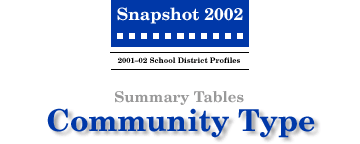

 |
 |
Districts are classified on a scale ranging from major urban to rural. Factors such as size, growth rates, student economic status, and proximity to urban areas are used to determine the appropriate group. All the charters are grouped together as one community type. The community types are:
2001-02 Community Type (Each column heading is a link to see the list of districts included in each category.)
Major Urban
Major Suburban
Other
Central City
Other CC Suburban
Independent Town
Non-metro Fast Growing
Non-metro Stable
Rural
Charters
9
75
38
141
68
46
244
419
180
1,175
1,652
1,034
944
532
168
1,054
821
241
STUDENTS
824,104
1,308,106
651,333
484,773
276,091
56,406
364,969
133,892
46,979
22
14
12
8
14
2
11
7
40
58
33
52
39
34
20
34
27
38
17
46
34
51
51
76
54
66
20
3
6
2
2
1
1
1
1
2
68.0
36.4
58.3
48.8
50.1
31.9
51.6
50.7
57.6
10
11
12
12
13
14
14
15
9
22
12
16
10
8
4
6
5
5
17
18
20
21
22
21
23
26
12
11
8
8
7
7
7
8
8
2
94.9
95.9
95.5
95.7
95.4
96.0
95.8
96.3
90.1
1.5
0.6
1.0
0.7
0.9
0.5
0.7
0.5
3.4
10.1
4.2
7.0
5.0
5.8
4.2
5.5
3.6
17.7
35,262
67,112
32,853
26,699
16,061
2,638
23,072
8,881
2,738
74.5
84.6
79.8
84.4
83.6
83.3
85.9
91.2
24.4
TAAS
% STUDENTS PASSING-ALL GRADES
SPRING '02
79.5
88.5
84.8
86.6
85.4
87.8
85.7
87.7
64.2
87.2
93.5
90.7
92.0
91.5
93.4
91.7
93.1
78.5
84.3
91.2
88.3
89.8
88.1
89.5
89.3
90.6
69.1
89.1
94.4
92.5
93.6
93.0
94.1
93.2
94.4
75.4
75.4
81.0
77.0
75.6
76.1
76.3
75.5
74.1
59.2
76.7
82.1
80.3
81.6
78.8
76.9
79.9
81.7
61.4
92.2
94.0
92.9
91.4
91.4
90.5
90.9
91.1
74.9
90.3
94.1
93.0
91.2
91.3
89.3
91.5
91.7
89.1
75.2
80.1
78.7
80.0
77.8
78.5
79.3
82.3
59.2
COLLEGE ADMISSIONS TESTS
(CLASS OF 2001)
63.0
69.8
56.4
60.2
58.5
64.1
61.9
69.0
5.8
21.3
34.6
26.1
22.8
22.9
23.1
20.8
18.5
19.6
927
1025
992
974
985
975
961
955
923
19.2
21.3
19.7
19.8
19.8
20.4
19.8
19.7
17.8
STAFF
107,458
163,510
88,344
69,470
39,367
7,948
55,287
23,493
5,188
52,189
86,491
43,943
33,404
19,139
4,248
27,825
12,589
2,754
1
1
1
1
1
2
1
2
3
3
3
3
3
3
3
3
3
6
17
8
8
6
7
6
6
4
7
49
53
50
48
49
53
50
54
53
9
9
11
12
13
11
13
13
9
23
27
28
30
28
25
27
24
21
72,144
76,225
71,722
69,153
68,002
68,473
64,911
60,376
51,580
62,534
62,600
58,391
55,717
55,030
56,251
53,424
51,746
40,446
35,368
48,855
45,689
44,243
42,685
43,581
41,869
38,264
28,623
41,755
40,773
38,586
37,772
37,107
36,791
36,804
35,872
29,486
61
30
49
37
30
12
28
17
65
7.7
8.0
7.4
7.0
7.0
7.1
6.6
5.7
9.1
15.8
15.1
14.8
14.5
14.4
13.3
13.1
10.6
17.1
TEACHERS
6.6
4.5
5.6
5.7
5.1
5.4
4.9
4.4
0.3
38.0
38.7
34.7
32.3
30.8
38.5
29.2
28.7
74.6
12.1
11.1
12.0
12.2
12.7
10.6
12.9
12.7
4.9
28.7
26.2
21.2
18.5
23.0
18.2
18.9
15.8
12.7
14.6
15.7
14.0
15.9
15.6
18.3
16.5
17.9
51.2
23
7
6
3
5
1
4
2
41
24
11
31
22
12
5
11
6
17
52
80
63
74
83
94
84
92
40
2
1
1
1
0
0
0
0
2
65
72
67
71
70
78
74
78
85
10
11
10
9
10
10
9
8
7
1
3
3
3
6
3
4
4
2
16
6
10
6
4
1
3
1
2
3
3
4
5
5
5
6
8
3
4
5
6
5
5
3
4
1
1
TAXES AND BUDGETED REVENUES
274,994
263,515
178,475
193,946
182,040
235,995
213,492
288,574
0
1.617
1.657
1.577
1.554
1.562
1.559
1.466
1.411
0.000
1,881
2,114
2,940
3,176
3,018
3,076
3,326
3,928
5,486
5,464,216,234
8,931,566,351
4,219,611,100
3,271,307,283
1,770,239,659
413,233,806
2,548,141,766
1,149,214,214
303,103,309
6,630
6,828
6,478
6,748
6,412
7,326
6,982
8,583
6,452
30
35
49
50
50
47
52
51
91
66
63
46
46
47
51
44
46
6
3
2
5
4
3
2
4
3
3
FUND BALANCES
378,242,864
1,153,232,451
518,523,881
463,960,558
224,303,935
85,894,815
462,458,965
263,451,266
24,568,968
7
14
13
16
14
22
19
23
10
BUDGETED EXPENDITURES
5,759,954,984
9,117,128,201
4,299,577,831
3,321,855,909
1,788,949,470
420,995,498
2,557,399,717
1,144,712,932
257,264,205
52
51
52
50
50
48
51
51
49
6
5
5
6
6
6
7
9
18
6
5
5
5
5
5
5
5
8
11
10
11
11
11
10
11
10
12
16
15
17
17
17
16
18
16
11
10
13
9
11
10
14
8
8
2
5,188,062,514
7,900,909,821
3,904,328,346
2,954,428,694
1,603,225,359
361,383,642
2,351,713,790
1,053,669,901
252,908,454
6,295
6,040
5,994
6,094
5,807
6,407
6,444
7,870
5,383
BUDGETED INSTRUCTIONAL EXPENDITURES
2,980,270,032
4,650,193,399
2,227,338,451
1,651,350,493
899,014,953
203,593,215
1,311,435,649
581,663,685
126,525,941
3,616
3,555
3,420
3,406
3,256
3,609
3,593
4,344
2,693
67
71
72
73
72
76
70
71
85
13
14
12
12
12
12
12
11
8
7
5
6
7
7
6
9
9
3
8
5
4
2
3
1
2
1
0
3
3
4
4
5
4
6
7
3
1
2
2
2
2
1
2
1
0

Summary Tables |
SNAPSHOT 2002 |
Performance Reporting |
TEA Home